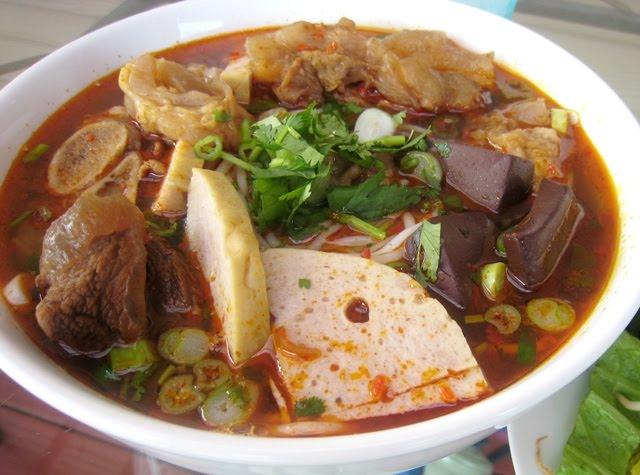Oodles of Vietnamese noodles
(VNF) - Vietnamese cuisine features dozens of noodle soups. Each region highlights its own specialties and flavours. A bowl of noodle soup is a symphony in which every ingredient is arranged in precise harmony and in a fixed order.
Bun thang
Bun thang is a brilliant example of the noodle soups of northern Viet Nam. Culinary expert Chiem Thanh Long said the dish is a perfect example of the precise mind-set of northern people and the culinary sophistication of the region.
“The dish is eye-catching at first sight. The bowl of bun thang looks like a colourful painting in which each colour is painted harmoniously, creating a pleasant feeling for our eyes. Traditional bun thang is made of nearly 20 multi-coloured ingredients synced in a chicken and pig bone broth. The mix is delicious and nutritious,” he said.
The word thang means "prescription". Historically, the word was associated with both northern Vietnamese and Chinese medicine. The soup is comprised of many healthy ingredients and was originally named for this mixture of good elements.
To make the dish, the cook first sprinkles salt on the chicken and rub it into the skin to remove some of the bad poultry smell. The chicken is boiled with grilled onion and ginger slices. Then the cook shreds the chicken meat finely.
The cook uses eggs to get the yellow colour in bun thang. The pan is greased with vegetable oil before frying the eggs. “Pour the egg mixture into the pan and tilt the pan in a circular motion to coat the base of pan. Quickly pour the mixture back to the bowl. You will get a very thin egg sheet,” Long said.
The egg sheets are sliced into thin strips. Then gio lua (Vietnamese pork roll), perfumed mushrooms, salty turnips, herbs and spring onion are cut into small threads and added to the dish.
 |
A hot bowl of bun thang can be topped with mam tom (Vietnamese shrimp paste) to enhance aroma and taste. (Photo: Internet)
Bun bo gio heo
Originating in Hue, the former capital of Vietnam, bun bo gio heo (noodle with beef and pig’s feet) is a hidden gem of the Vietnamese cuisine of the central region. It’s a rich and spicy soup with deep layers of lavor. The broth is paired with tender slices of beef and pig’s feet, and then topped with lots of fresh herbs, including banana flowers.
A bowl of lemon water is prepared for the banana flowers, the petals are then removed and any mini bananas are discarded. The lemon water keeps the petals from browning and removes some of the bitterness.
Cubes of congealed pork blood are another integral part of this dish. They are slightly chewy and jellylike.
What makes a bowl of bun bo gio heo exceptional is mam ruoc (fermented shrimp paste) which is made from ruoc, little shrimps caught in the central sea region.
Famed chef Vo Quoc learned how to cook authentic bun bo gio heo from an elderly upper class Hue woman.
“The beef and pork must be boiled in separate cauldrons. That’s one of the secrets,” chef Quoc said.
“Her recipe and methods are different from how I used to cook the dish. Her way creates an extraordinary bowl of bun bo gio heo.”
The scent of lemongrass, mam ruoc, satay sauce and onion should pervade a good broth. The people of the central region love hot and spicy food, so the dish should meet these criteria but not burn the tongue.
 |
“If it’s too hot, people won’t sense the harmonious taste of the ingredients and enjoy the dish,” Quoc said. (Photo: Internet)
Bun bo Nam Bo
The beef noodle soup of the south is made completely differently than in Hue.
In the southern region, the noodles are paired with a sauce which is both cool in temperature and non-spicy. Locals speak fondly of the simplicity and elegance of a dish which soothes the tongue in hot weather year-round.
The most important steps of making this dish are marinating the beef properly, making the sauce, and arranging the ingredients together perfectly. The beef should be marinated well in sugar, fish sauce and pepper and other seasonings before cooking.
“The dish is comprised of different herbs and can be served cold. It is not too spicy, oily or greasy. People don’t tire of it, even when they eat it regularly,” said Nguyen Thi Phuong, 60, the owner of Phuong Bach restaurant at 67 Hang Dieu Street in Hanoi for almost 30 years.
“It took me many attempts to make the perfect sauce. The sauce is a harmony of sour, sweet and salty tastes.”
Shredded lettuce is placed in a big bowl, then rice vermicelli, sliced cucumber, mint and bean sprouts. Beef, pickled carrot and papaya are added. The specialty sauce is poured on everything and the dish is topped with crushed grilled peanuts. Then just mix everything together and it’s ready to eat!
 |
Assembling the dish requires a chef’s aesthetics. (Photo: Internet)
( Compiled by VNF )
Recommended
 Travel
Travel
Vietnam Through Australian Eyes: Land of Flavor, Warmth, and Timeless Charm
 Travel
Travel
Strategies for Sustainable Growth of Vietnam’s Tourism from International Markets
 Travel
Travel
Vietnam Strengthens Its Presence On The Global Tourism Map
 Multimedia
Multimedia
Phong Nha-Ke Bang National Park Named Top Adventure Travel Site
Popular article
 Travel
Travel
Vietnam Welcomes Record-High Number of International Visitors
 Travel
Travel
Luxury Train From Hanoi To Hai Phong To Be Launched In May
 Travel
Travel
Phong Nha Named Top Budget-Friendly Travel Destination for Spring 2025: Agoda
 Travel
Travel



